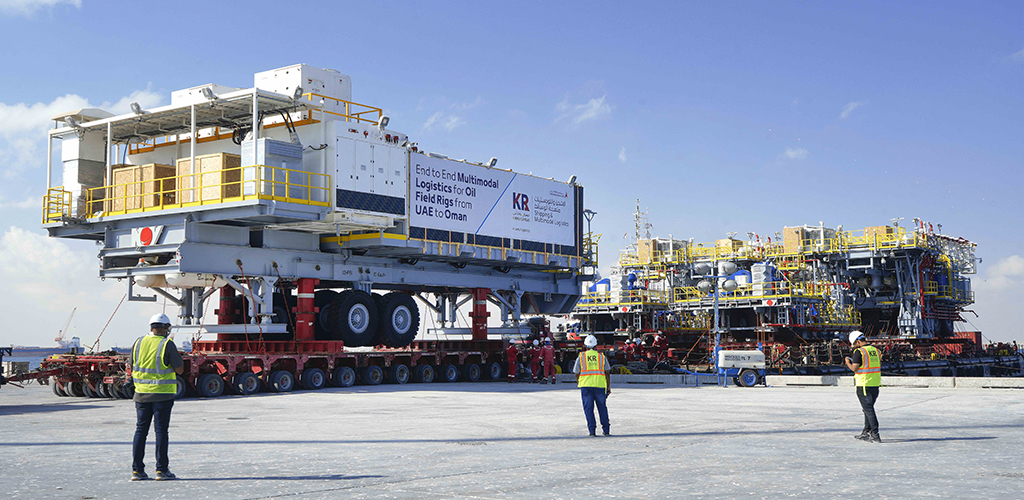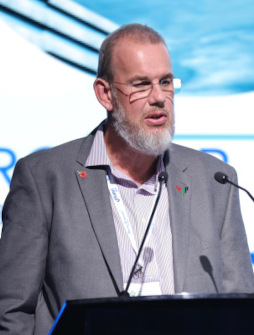Jan 17 | 2024
Sultanate Embarks on a Series of Mega Construction Projects
 By Heba Hashem
By Heba HashemAs Oman embarks on a series of mega construction projects, we find out the obstacles that logistics providers face at the sultanate's ports and terminals.
From Issue 1, 2024 of Breakbulk Magazine
Oman’s planned establishment of mega urban developments has seen dozens of contracts awarded in recent months as the country looks to develop future-ready, climate-resilient cities.
Guided by the strategic directions of Oman Vision 2040, a blueprint for the country’s future development, the Ministry of Housing and Urban Planning has started working with international companies on the sustainable development of these new cities.
The first of Oman’s futuristic projects, Sultan Haitham City, will house 100,000 people when completed by 2045. Announced in May 2023, the metropolis will comprise 19 neighborhoods across 2.9 million square meters of undeveloped land in Al Seeb, a suburb of greater Muscat. The city will introduce public spaces and more than 20,000 new homes constructed with local materials, while connecting with a new mass transit system that is set to improve connectivity along the country’s coastline.
“Sultan Haitham City in Muscat Governorate is based on the outcomes of the Oman National Spatial Strategy, the urban guideline for the next 20 years. The project aims to establish a new model for the sustainable development of cities that caters to the aspirations of young people,” a spokesperson the Ministry of Housing and Urban Planning told Breakbulk.
As the country’s first smart city, the project will incorporate sustainable strategies and technologies such as advanced traffic management systems. The masterplan also involves transforming a 7.5-kilometer-long dry river into a public green park that can hold water in severe flood events.
Project Partners
London-based architecture firm Skidmore, Owings & Merrill is designing the mega city, which will be carried out in four phases. Other project partners include Singapore-based Meinhardt Group, the engineering consultant, and Canadian firm MT Planners, the landscaping consultant. In addition, Maxwell Cavendish, a United Arab Emirates-based chartered surveying firm and property consultancy, carried out the financial feasibility study for the project, the Ministry spokesperson said.
Construction on the city is set to start in 2024 and preparations are moving rapidly, with the housing ministry signing agreements with two developers in June: Oman’s Al-Siyabi International Group and Qatar-based Ariane Real Estate.
As of June 2023, the housing ministry had signed development and partnership agreements worth more than US$3.1 billion for the new mega city, Muscat Daily reported. In November, the ministry floated two additional tenders, for enabling works and construction of residential units.
Most of the contracts with international firms were awarded through Oman’s investor-friendly public private partnership, or PPP, law, which came into force in 2019.
Moreover, in May 2023, the government rolled out the Oman Future Fund, an investment fund with a capital of US$5.2 billion, to encourage the private sector to enter partnerships and finance feasible investment projects within the Vision 2040 framework.
According to Oliver Cornock, editor-in-chief at global advisory and research firm Oxford Business Group, Oman’s recently improved PPP law will be key in helping to boost inflows for upcoming projects, including the sizeable infrastructure expansion works taking shape.
“Many of these transport initiatives, including planned ports, roads and airports, are supporting Oman’s plans to develop its tourism industry and attract investment for the manufacturing segments, which, in turn, will broaden the economic base,” Cornock said.
Three New Mega Projects
The Ministry of Housing and Urban Planning is also moving forward with three other mega projects: Rathath Boulevard in Dhofar, Aames Bay in Musandam and Rimal Park in South Batinah. It selected these projects in June 2023 from 11 proposals made by different governorates through its annual competition. All three projects will receive government support and involve private sector participation through PPPs.
 Cris Partridge, a master mariner and managing director at Abu Dhabi-based Myrcator Marine and Cargo Solutions, expected project cargo requirements for these urban development projects to be focused on specific equipment.
Cris Partridge, a master mariner and managing director at Abu Dhabi-based Myrcator Marine and Cargo Solutions, expected project cargo requirements for these urban development projects to be focused on specific equipment.“Oman has massive natural resources which allows them to indigenously produce concrete and similar building materials. The country’s steel industry is booming with the Jindal Shaded Iron and Steel facility in Sohar expanding its production to reach a capacity of 2.4 million metric tons per annum. It is unlikely therefore that huge amounts of building materials will need to be imported to complete these projects. The challenge, I believe, will be moving these materials from the point of origin to the construction sites," said Partridge, who has been working in the Middle East since 2001.
"Additionally, it is likely to be the high-ticket items for each of these projects that will require the importation of high value, long lead time equipment, such as transformers and distribution equipment."
Funding Support
Dhofar governorate’s Rathath Boulevard is the largest of these new projects. Spread across a 470,000 square-meter area, the development will be implemented at a cost of US$104 million over a span of four years. It will feature the Salalah Eye Ferris wheel, fountains, suspended walkways, an artificial waterway, alongside restaurants and shopping areas. The recreational destination is expected to draw 800,000 visitors during the region’s monsoon period.
Oman’s Ministry of Finance is providing US$26 million funding for the first phase of infrastructure and related services, while the rest will be financed by private-sector institutions.
Moreover, in November, Oman Development Bank signed financing and investment agreements worth US$31 million for the benefit of small and medium-sized enterprises operating in Dhofar. These included a new financing product dedicated for Rathath Boulevard projects.
Dhofar, the largest of Oman’s 11 governorates, is the location of the first utility-scale wind farm in the Middle East, a 50-megawatt power plant that came online in 2019. Its capital, Salalah, is also home to the largest port in Oman. “Salalah is well established and able to handle large amounts of cargo with ease. As a major container transhipment hub, the facilities and experience are already in place,” Partridge said.
The second project, Rimal Park in South Batinah, will be built along the Batinah Expressway at a cost of US$18 million and is one of several projects that aim to capitalize on the tourism potential of the governorate. Covering 225,000 square meters and targeting completion in two years, it will feature a cable car, a resort and an amusement park.
Meanwhile, the Aames Bay development, also costing US$18 million, will be built over an area of 68,7000 square meters and is slated for completion within 21 months. Located in Khasab, the capital of the mountainous peninsula Musandam, the project aims to enhance connectivity and infrastructure, stimulate tourism and create new investment opportunities in the governorate.
Connectivity Issues
“There will be a requirement for the marine transportation of materials to at least two of the regions. For Dhofar [location of Rathath Boulevard], the port of Salalah is the obvious choice and for Musandam [Aames Bay], the Port of Khasab is the only choice,” said Partridge, who is a preferred expert for marine and cargo related disputes at the Oman Commercial Arbitration Centre.
“As for the South Al Batinah project [Rimal Park], it is just north of Muscat and is well serviced by highways. It is my thought that this project will be primarily supplied by road transportation, although materials could be shipped into both Sohar and Muscat,” he said.
Sohar, a port city on Oman’s northern coast and the capital of North Al Batinah, imports and exports a diverse range of products and is well placed to expand it capabilities, according to Partridge. “Breakbulk cargoes are frequently handled in Sohar Port and C. Steinweg Oman* [part of the Netherlands-based warehousing and logistics service provider] have a long history of specialized cargo handling both there and in Europe.”
On the other hand, Musandam, where Aames Bay is being planned, is a particularly challenging location as there is no road link between it and the main body of Oman that does not involve crossing 50 kilometers of UAE territory, Partridge noted. While there are plans to enhance the Port of Khasab, including proposals for an amphibious airbridge, the port has historically serviced smaller vessels.
“The Port of Khasab has a protected 10-meter-deep harbor basin with three berths of 60 meters, 90 meters and 300 meters, as well as 22 hectares of open yards and 4,000 square meters of covered sheds. Smaller breakbulk vessels can berth here, and landing craft are frequently utilized for moving cargo in and out of the port,” Partridge said.
Since 2019 the port has been part of the Asyad group*, the biggest port operator in Oman. “It is likely that their expertise in operating other ports has enhanced Khasab’s facilities and skills base,” Partridge said.
All in all, the main challenge with breakbulk and project cargo logistics in Oman is associated with the onward movement of cargo from the ports to final destinations inland. That said, the main ports — Sohar, Duqm and Salalah — have been built with thought and foresight.
“These ports’ facilities are world class and able to match European ports for cargo handling. The ongoing development in Oman is bringing railways and new main roads that will directly link the ports to producers and end users in the interior of the country. Until that infrastructure is completed, the inland movement of materials will be by trucks,” Partridge said.
Cris Partridge will be moderating the main stage panel session “Futureproofing Your Market Position” at Breakbulk Middle East 2024. The session, which features speakers David Galea at Licena Group, Vanessa Welch at V3 Consulting, and Martyn Cowie at Tyde Digital, will take place on Tuesday, 13 February at 12:45-13:30.
Breakbulk Middle East 2024 is happening on 12-13 February at the Dubai World Trade Center in the UAE.
MAIN PHOTO: Khimji Ramdas Shipping moves OOG units in Oman. CREDIT: KRS.
